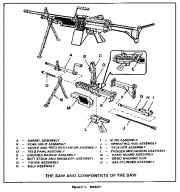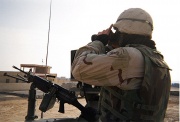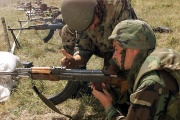Squad automatic weapon

A squad automatic weapon (SAW, also known as section automatic weapon or light support weapon) is a light or general purpose machine gun, usually equipped with a bipod and firing a rifle-caliber round. A SAW is used to provide suppressive fire for an infantry squad or section. Typically the ammunition used is interchangeable with assault rifles carried by other members of the unit,[1] simplifying military logistics.
The basic use of this weapon is to force enemy troops to take cover and reduce the effectiveness of their return fire while friendly troops attack. This increases the likelihood of a successful attack against an enemy position. A SAW must be light enough for an individual soldier to carry and fire from the shoulder.
A SAW can also be used to defend against a massed assault.
Many SAWs (such as the RPK-74 and L86) are modified assault rifles. The most common SAWs in use today are derived from two basic patterns: RPK or FN MINIMI. One of the first weapons designed for this role was the M1918 Browning Automatic Rifle, which, though having a limited magazine capacity, was still higher than the typical infantry rifle, and it gave the infantry a base of fire weapon that was more suited to maneuver warfare than the bulkier machine guns of the period, such as the M1919 Browning machine gun.
Although the acronym "SAW" refers to all of these types of weapons, it is most often automatically (and incorrectly) thought as the M249 SAW.
[edit] Doctrine
Assault rifles often provide a fully automatic setting, but troops too often become excited in combat and waste large amounts of ammunition. Therefore, in many modern armies, military doctrine requires the ordinary soldier to avoid using his weapon's fully automatic mode unless defending against a mass assault or an ambush.
This doctrine greatly reduces logistic loads, including combat pack weights, aerial resupply, and fuel requirements. It reduces training requirements and expense. It also extends patrol time for a typical soldier.
The problem is that this doctrine provides no fire support during an assault. The SAW was invented so that a machine gun could be carried on assaults. It is a specialist weapon to avoid unnecessary use of ammunition, and reduce both the training and combat pack loads of a squad.
When applied to civil or irregular militia, this doctrine makes private purchase of ammunition affordable, and allows militia to train and operate with standard military doctrines using nonmilitary repeating rifles. In war time, such lightly equipped civil militia can be easily upgraded by distributing relatively few SAWs, one per squad, and training.
Further benefits:
- SAWs require less training than medium or heavy automatic weapons. Fully automatic weapons require large amounts of expensive live-fire training before troops learn to actually hit targets while not wasting ammunition. SAW doctrine reduces training costs by limiting advanced training to a few picked specialists, usually the men who carry the weapon and its spare ammunition.
- SAWs are more effective than assault rifles in fully automatic mode. Hand-held fully automatic fire is difficult to control and is less likely to hit an incapacitating part of the enemy's anatomy. A SAW usually has a bipod, which permits the operator to rest the weapon on the ground or other object, increasing stability and reducing operator fatigue.
- SAWs are more reliable than assault rifles under intense firing. A practical assault rifle needs to be lightweight, and is therefore prone to overheat or malfunction under the stresses of continuous fully automatic fire. Because it is carried by a specialist with a specialized pack load, a SAW can have a heavier barrel and a sturdier action without unduly burdening the entire squad.
[edit] See also
- CETME Ameli
- Heckler & Koch HK11
- Heckler & Koch HK21
- Heckler & Koch MG4
- Dror LMG
- FN FAL
- C2A1
- L2A1
- RPD
- Madsen machine gun
- Bren Gun
- Lewis gun
- AR-10
- Ultimax 100
- M60 machine gun
- MG3
- M249 SAW
- MG34
- MG42
- M240
- Mk 48 Mod 0 machine gun
- FG42
- FN Minimi
- L86
- QBB-95
[edit] References
- ↑ Presentation of the KvKK 62 at www.mil.fi (in Finnish).

